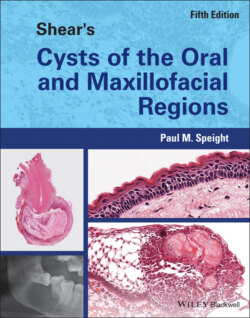Читать книгу Shear's Cysts of the Oral and Maxillofacial Regions - Paul M. Speight - Страница 55
Accumulation of Cholesterol
ОглавлениеDeposition of cholesterol is a characteristic feature of long‐standing chronic inflammation at any site and is due to deposition and crystallisation of lipids, probably derived from degenerating cell walls. It is, for example, a prominent feature in atherosclerotic plaques, arthritis, appendicitis, and cholecystitis.
Deposits of cholesterol crystals are found in many radicular cysts, but by no means in all. The reported frequency varies from study to study and appears to be between about 10% and 45%. In one of the largest studies, Browne (1971b ) examined 402 radicular cysts and found evidence of cholesterol deposition in 43.5%. In other studies, the frequencies have been 9.4% (Lin et al. 2010 ), 28.5% (Shear 1963b ), and 30% (Trott and Esty 1972 ). However, it is likely that if entire cyst linings were examined instead of random sections, the frequency would be higher. Browne (1971b ) showed that there was a statistically significant correlation (P < 0.01) between the presence of cholesterol and haemosiderin, and suggested that the main source of cholesterol was from disintegrating red blood cells in a form that readily crystallises in the tissues. This was confirmed by Arwill and Heyden (1973 ), who showed that the crystals may form in congested capillaries in the inflamed areas as they appear to be enveloped by endothelial cells. Trott et al. (1973 ) also found a close correlation between the occurrence of cholesterol and haemosiderin‐containing macrophages as well as free haemosiderin in the tissues. However, their regression analysis showed that only 35% of the cholesterol may be formed from this association, suggesting that accumulation of cholesterol may also derive from degenerating lymphocytes, plasma cells, and macrophages.
Cholesterol crystals are small, rectangular or rhomboid plate‐like crystals, which characteristically have one corner notched or cut off. They can be visualised in fresh smears of fluids or cyst contents, where they are strongly birefringent, producing an array of colours from red/orange to pale blue. Once the cholesterol crystals have been deposited in the tissues, they behave as foreign bodies and excite a foreign body giant cell reaction. They cannot, however, be seen in routine histological sections, because they are dissolved out of the tissues by the solvents used during processing. This leaves characteristic cholesterol clefts, surrounded by fibrous tissue and dense aggregations of multinucleate giant cells (Figure 3.16b). In radicular cysts the cholesterol masses form in the fibrous wall and are associated with heavily inflamed granulation tissue, and are sometimes referred to as ‘cholesterol granulomas’. These masses are often extruded from the fibrous wall through the epithelial lining into the cyst lumen and appear macroscopically and microscopically as a ‘mural nodule’ (Figure 3.16a). Once the entire mass has passed into the cavity, the epithelial breach may heal and cholesterol crystals may lie free in the cyst lumen (Shear 1963b ).
Figure 3.16 Cholesterol clefts in a radicular cyst. (a) An accumulation of cholesterol has formed a nodule that ruptures the cyst lining and protrudes into the lumen. (b) Multinucleate foreign body giant cells on the surface of cholesterol clefts in the wall of a radicular cyst.
Occasionally isolated or scattered clefts may be seen within the cyst wall. High‐power examination shows that each cleft is surrounded by one or more large multinucleated giant cell (Figure 3.16b), an indication that the crystals are recognised as foreign bodies. The persistence of cholesterol crystals in the tissues and the accumulation of macrophages may be an important cause of persistent chronic inflammation, and is thought to be a major factor in the persistence of non‐healing periapical lesions after endodontic treatment of the offending tooth (Nair 2006 ). Slutzky‐Goldberg et al. (2013 ) compared the incidence of cholesterol in periapical lesions in young and elderly patients, and found that the elderly (over 60 years) had a significantly higher incidence of cholesterol than young (13–21 years) patients. They suggested that this may be associated with increasing serum cholesterol with age, and that it may also be a factor in non‐healing of periapical lesions in older age groups. It is equally likely, however, that the increased frequency in the elderly is associated with the length of time the lesion, and associated chronic inflammation, has been present.
A number of other features are typically seen in radicular cysts, but these are not specific and are also associated with long‐standing chronic inflammation. As noted above (Browne 1971b ), deposition of haemosiderin pigment is common. Browne (1971b ) found haemosiderin in 61.4% of radicular cysts and noted a correlation with cholesterol and also with accumulation of foamy histiocytes. Haemosiderin is often found within histiocytes and Lin et al. (2010 ) found haemosiderin‐laden and foamy histiocytic in 6.0% and 6.8% of radicular cysts, respectively (Figure 3.17). Buchner and David (1978 ) demonstrated the presence of pigmented cells in 42% of radicular cysts. However, in this study the pigment was not haemosiderin, but was identified as lipofuscin. It was found in association with haemosiderin deposits and cholesterol, and Buchner and David suggested it was also associated with the inflammatory process in the cyst wall. Lipofuscin is pale yellow‐brown in colour, is positive with PAS stain, negative for Perls Prussian blue, and shows a yellow autofluorescence under ultraviolet (UV) light. It can thus be differentiated from haemosiderin, which is dark brown in colour, PAS negative, and positive for Perls Prussian blue.
Figure 3.17 A focal accumulation of plump, foamy histiocytes in the wall of a radicular cyst.
As mentioned above, foamy histiocytes are also commonly seen in the walls of radicular cysts (Figure 3.17). Most often they are scattered or form small focal accumulations in areas of inflammation or are associated with cholesterol clefts. Occasionally, however, sheets of large, pale foamy histiocytes may be encountered, which appear disconcertingly like a xanthogranulomatous reaction.
